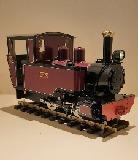Catia Interpreter for LinuxCNC
- t1m0n
- Offline
- Junior Member
-

Less
More
- Posts: 34
- Thank you received: 0
12 May 2013 17:38 #33944
by t1m0n
Catia Interpreter for LinuxCNC was created by t1m0n
Hi,
I know how to generate G-Code from a part in Catia but only for special Control-Units which comes with an interpreter-software.
My question is, if there exist an interpreter for Catia which is able to deliver G-Code from a part specific for LinuxCNC?
I found nothing in the internet but i think I'm not the only one who search for this.
I know how to generate G-Code from a part in Catia but only for special Control-Units which comes with an interpreter-software.
My question is, if there exist an interpreter for Catia which is able to deliver G-Code from a part specific for LinuxCNC?
I found nothing in the internet but i think I'm not the only one who search for this.
Please Log in or Create an account to join the conversation.
- andypugh
-

- Offline
- Moderator
-

Less
More
- Posts: 23460
- Thank you received: 4992
14 May 2013 03:51 #34034
by andypugh
LinuxCNC uses standard G-code. What postprocessors are available? If you just choose the most basic G-code output you should be OK.
Replied by andypugh on topic Catia Interpreter for LinuxCNC
My question is, if there exist an interpreter for Catia which is able to deliver G-Code from a part specific for LinuxCNC?
LinuxCNC uses standard G-code. What postprocessors are available? If you just choose the most basic G-code output you should be OK.
Please Log in or Create an account to join the conversation.
- emcPT
-

- Offline
- Platinum Member
-

Less
More
- Posts: 702
- Thank you received: 139
14 May 2013 04:38 #34038
by emcPT
Replied by emcPT on topic Catia Interpreter for LinuxCNC
If you use a postprocessor that outputs G0, G1 G2 and the basic M codes then it will most probably work.
Please Log in or Create an account to join the conversation.
- verticalperformance
-

- Offline
- Senior Member
-

Less
More
- Posts: 59
- Thank you received: 14
24 May 2013 18:35 - 24 May 2013 18:37 #34635
by verticalperformance
Replied by verticalperformance on topic Catia Interpreter for LinuxCNC
There are a handful of trial post processors that DS supply with CATIA. None of them give a perfect result with LinuxCNC (and they are all marked as "trial use only - not for production", but the Fanuc30 is pretty close, as are the ISO lathe and mill. You will need to edit the first few lines of the Gcode typically, and it seems to put in a lot of G28 codes.
One trick I use is to have CATIA insert a Post Processor instruction to put in the pre-amble (like G20,21), and also things like feed rates. You program with a random (but known eg 99) feedrate, have a PP instruction like INSERT#<Roughing_Feed> = 99 which generates a parameter in your G-Code. Then use a text editor on the G-Code to search for F99 and change it to F#<Roughing_Feed> and you now have parameter driven feed rates in your G-Code.
If you are using CATIA to generate G-Code in a production environment, you probably would pay someone to make a specific Post Processor for your application.
Another option is to use something like WINPOST to convert the CATIA generated APT files to G-Code. (essentially you are rolling your own post)
One trick I use is to have CATIA insert a Post Processor instruction to put in the pre-amble (like G20,21), and also things like feed rates. You program with a random (but known eg 99) feedrate, have a PP instruction like INSERT#<Roughing_Feed> = 99 which generates a parameter in your G-Code. Then use a text editor on the G-Code to search for F99 and change it to F#<Roughing_Feed> and you now have parameter driven feed rates in your G-Code.
If you are using CATIA to generate G-Code in a production environment, you probably would pay someone to make a specific Post Processor for your application.
Another option is to use something like WINPOST to convert the CATIA generated APT files to G-Code. (essentially you are rolling your own post)
Last edit: 24 May 2013 18:37 by verticalperformance.
Please Log in or Create an account to join the conversation.
Time to create page: 0.070 seconds
